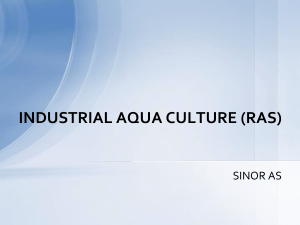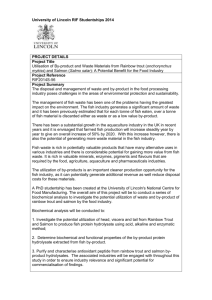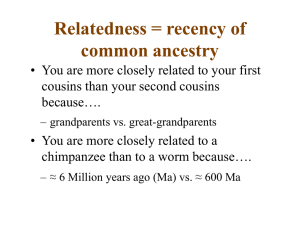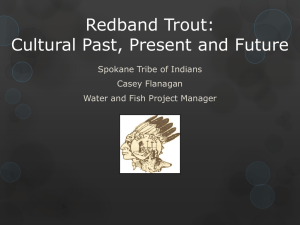ANNEX Current status of samples taken for SALSEA Merge and
advertisement
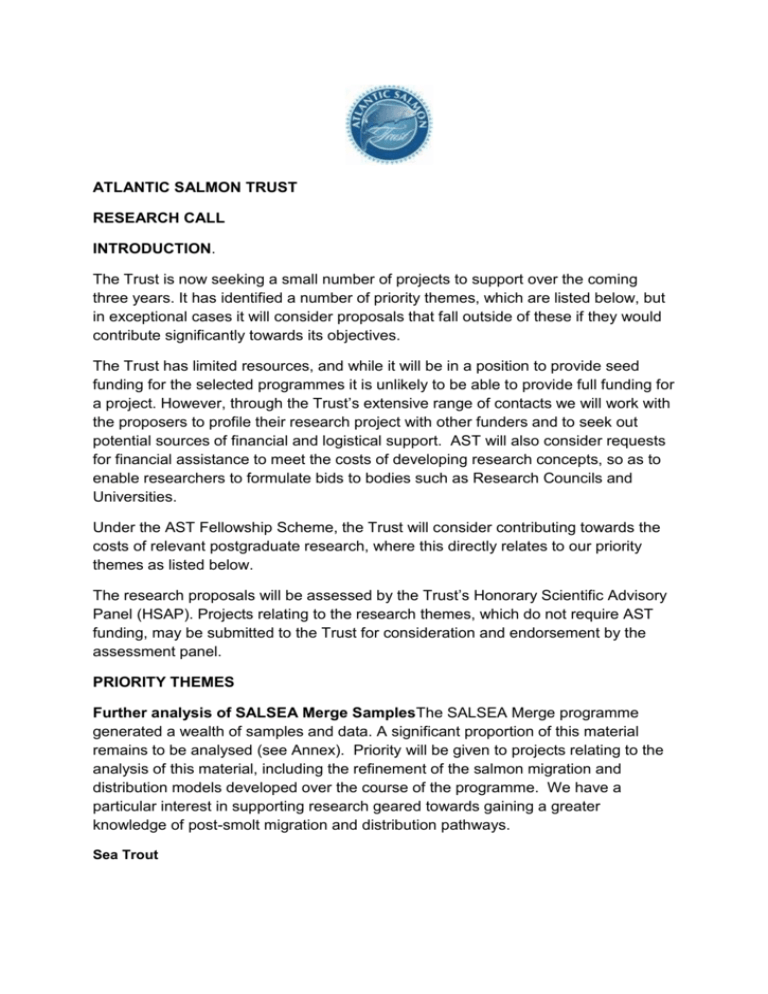
ATLANTIC SALMON TRUST RESEARCH CALL INTRODUCTION. The Trust is now seeking a small number of projects to support over the coming three years. It has identified a number of priority themes, which are listed below, but in exceptional cases it will consider proposals that fall outside of these if they would contribute significantly towards its objectives. The Trust has limited resources, and while it will be in a position to provide seed funding for the selected programmes it is unlikely to be able to provide full funding for a project. However, through the Trust’s extensive range of contacts we will work with the proposers to profile their research project with other funders and to seek out potential sources of financial and logistical support. AST will also consider requests for financial assistance to meet the costs of developing research concepts, so as to enable researchers to formulate bids to bodies such as Research Councils and Universities. Under the AST Fellowship Scheme, the Trust will consider contributing towards the costs of relevant postgraduate research, where this directly relates to our priority themes as listed below. The research proposals will be assessed by the Trust’s Honorary Scientific Advisory Panel (HSAP). Projects relating to the research themes, which do not require AST funding, may be submitted to the Trust for consideration and endorsement by the assessment panel. PRIORITY THEMES Further analysis of SALSEA Merge SamplesThe SALSEA Merge programme generated a wealth of samples and data. A significant proportion of this material remains to be analysed (see Annex). Priority will be given to projects relating to the analysis of this material, including the refinement of the salmon migration and distribution models developed over the course of the programme. We have a particular interest in supporting research geared towards gaining a greater knowledge of post-smolt migration and distribution pathways. Sea Trout The Trust’s Sea Trout Workshop, held in Bangor, Gwynedd in February 2011, identified a number of priorities for research on sea trout: - see http://www.atlanticsalmontrust.org/library/library10.pdf. There is also a need to follow-up the results of research carried out within the Celtic Sea Trout, Living North Sea and AARC INTERREG projects. The Trust is particularly interested in work on the following topics: utilisation of estuaries by sea trout at all life stages coastal tracking of sea trout (see below) survival and movement of post-smolts residency and anadromy in specific rivers the importance of small streams for trout and other salmonids (in particular proposals addressing the recommendations for further research in the report of the workshop on small streams held in Carlingford on 27and 28 November 20121: http://www.atlanticsalmontrust.org/library/library12.pdf.) Near Shore AST would welcome research proposals relating to the tracking of salmon and sea trout, migration and distribution patterns in estuaries and bays along the coast. Projects which include the establishment of tracking arrays would be of particular interest, as would projects which encourage partnerships with technology firms to review and refine existing tracking methodologies. Salmon and Sea Trout Scales The Trust is working to develop a comprehensive archive / meta-database of sea trout and salmon scales. As part of this process, it wishes to initiate a research project on scale use and preservation, with the aim of developing a protocol. The project should identify when 1 Research is needed: 1. on the movement of immature salmon and trout, within and out of small streams; 2. on the role and importance of coastal streams in contributing to sea trout numbers at sea; 3. to improve our knowledge of the macroinvertebrate communities and productivity of small streams, their significance in terms of overall catchment biodiversity and of the contribution made by aquatic macroinvertebrates from headwater streams to salmonid diets. The use of stable isotope analysis for the latter should be explored; 4. to improve understanding of trout migration patterns, and to establish the relative proportions of resident and migratory fish, within individual populations, as part of the study of life history choices in trout recommended by the Sea Trout Workshop, and for research into simple, and cost-effective ways of doing this; 5. to ascertain, using genetic analysis, population structures of migratory and resident trout within catchments, including small stream. scales need to be preserved and the circumstances under which they can be subject to destructive analysis (e.g. genetic and isotopic analysis); the project should also undertake a comparative analysis of preservation techniques. Projects relating to the analysis of marine growth patterns from current and historical scale collections will be of particular interest, as will projects which encourage the use of the scale reading protocols and techniques developed as a component of SALSEA Merge Aquaculture Priority will be given to projects which assess aquaculture related impacts, such as sea lice infestation levels and genetic introgression, on the survival and health of wild salmon and sea trout. AST would also welcome proposals relating to the impact of escapes, from freshwater rearing facilities, on neighbouring wild salmon populations APPLICATIONS Applications should be in writing, although the Trust is happy to discuss ideas informally beforehand. Applications should include: a brief description of the proposed project (no more than 2 pages / 1000 words), covering the aims of the project, the methods to be employed, the planned timescale, and where relevant, appropriate web-links to related projects ; the estimated cost of the project, what other partners will be involved and what sources of funding have been identified (as indicated above, the Trust will work with the proposer to identify potential partners and sources of funding) ; how the proposed project will contribute towards the AST’s priority themes or to the AST’s overall objectives; in what way the AST can contribute to the proposed project (for example, seed funding, meeting project development costs, endorsement). Anyone wishing to discuss a possible application should contact the Trust Research Director, Ken Whelan, at ken.whelan@hotmail.com or Ivor Llewelyn at ivor@linkwell.org.uk. Applications should be addressed to the Trust’s Chief Executive, Tony Andrews at director@atlanticsalmontrust.org, and must be received by 19 April 2013. ANNEX Current status of samples taken for SALSEA Merge and additional samples and work to be completed from the SALSEA Merge post-smolt programme. Fish samples Details of external biological characteristics of all captured fish (approximately 1,700 post-smolts and 53 adults) have been recorded and entered in a SALSEA Merge database. Details include whether the fish were wild or hatchery origin, their length, weight, scale loss, presence of cataracts, presence of external parasites, presence of external tags or finclips. Sex information was noted for 1,300 plus samples. Summaries based on this material were presented in the SALSEA Merge report. There is more scope for further publication on the detail of this information. In addition, all fish were sampled for genetic stock identification. The origin of these samples (either to river or area of origin) have been reported in the SALSEA Merge final report and in subsequent papers. Further work is being considered to refine assignments using SNPS and it is likely that further publications will arise from the original SALSEA Merge samples. Samples are held at various SALSEA partner institutions. Scales were removed from all fish and the results of the post-smolt analyses have been presented in the SALSEA Merge report and in subsequent publications. There is scope here for further publications relating post-smolt growth and marine survival/conditions. In addition, over 23,000 scales of Atlantic salmon from seven rivers, located in six countries have now been analysed with the new scale reading technique. Most scales are from 1970 to the present, with some limited information for one stock extending back to earlier periods. The number of circuli laid down in the marine zone of the scales in specific periods as well as the distance between the circuli were measured, and this information was summarised in the final SALSEA Merge report. Since then a MI Ireland, IMR Norway and Loughs Agency, Ireland/N.Ireland study has been initiated which will increase the number of sample rivers from which archive scale material is available and the results generated in SALSEA Merge will be extended and reinterpreted at a larger scale. Gonads were preserved and retained for further analyses from approximately 270 post-smolts. These tissues have not been analysed as yet and would provide more insights into the developmental rate of post-smolts at different stages of the migration. Samples are stored with the agencies who collected the samples. The presence of internal parasites was noted and in most cases enumerated for samples dissected on-board the vessels or in labs. Whole fish were retained and preserved in formalin from approximately 10% of samples taken in the Irish trawl surveys and these have been processed. A small number of samples remain frozen for processing and will be included within the MI Ireland, IMR Norway and Loughs Agency, Ireland/N.Ireland study. Tissues samples from approximately 1,000 fish were retained for stable isotope analyses and a similar number of fish was sampled for lipid content analyses. These tissues have not been analysed. Gills and viscera were retained either frozen or preserved in alcohol from approximately 1,200 samples. Samples taken in the Irish trawl surveys have been included in a PhD programme initiated by MI Ireland, IMR Norway and Loughs Agency, Ireland/N.Ireland as an immediate follow up to the SALSEA Merge programme. Stomach contents were made available for approximately 750 post-smolts, while 1,400 stomachs from other pelagic species (herring and mackerel) were also available. Preliminary analyses were presented in the final SALSEA Merge report and were also presented verbally at the SALSEA symposium in La Rochelle. Data and samples are with IMR in Norway. Remaining samples from Irish trawl surveys have been included in a PhD project initiated by the MI Ireland, IMR Norway and Loughs Agency, Ireland/N.Ireland. Oceanographic information 206 plankton tows were carried out using both horizontal tows and vertical tows. 26 specific krill trawls were also taken. These samples have not been analysed extensively to date but are with the IMR in Norway. 173 stations were sampled using Constant Temperature and Depth sensors (CTD). Information from these sensors was included within the migration model which was presented in the final SALSEA Merge report and as a subsequent publication. The model is capable of providing putative migration routes for salmon by varying oceanic parameters and is, therefore, useful for more exploratory analyses than have been carried out to date. The model is available from IMR, Norway. Chlorophyll samples were retained from 120 stations and 97 samples were retained for nutrients at sea. These samples require analysis A range of oceanographic parameters was recorded from on-board ship monitors including salinity, temperature, depth etc. Most of the data have been included within the oceanographic model. However, there is scope for more in depth analyses of oceanic factors affecting the migrations of salmon post smolts.

